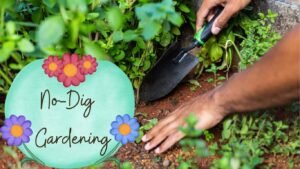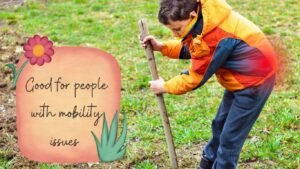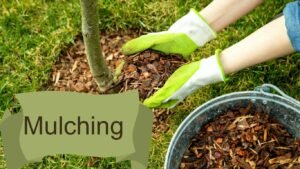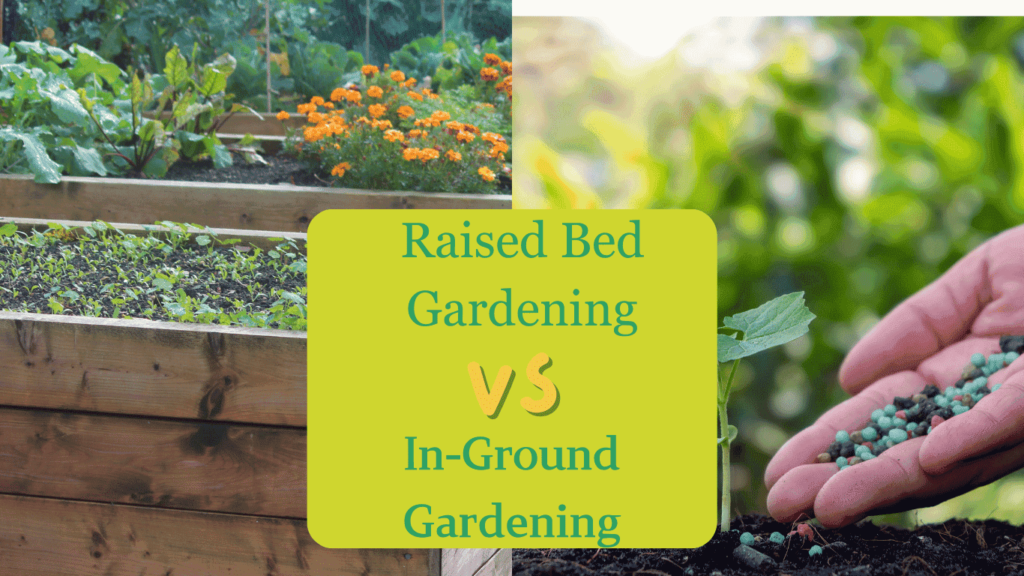No-dig gardening, also known as no-till gardening, is gaining popularity nowadays because it’s a sustainable and ecological gardening practice. When you do no-dig gardening, you minimize soil disturbance and maintain the natural structure of microbial life in the soil, which is good for soil health.
You can start with no-dig gardening, even if you are a beginner gardener. You won’t have to hire a lot of labor for maintenance like digging. You will just build a simple layer of compost, mulch, and other organic material on the top of existing soil.
What is No-Dig Gardening?

No-Dig Gardening, also known as No-Till and Zero-Tillage Gardening. It’s a simple approach that requires you to do gardening without too much soil disturbance.
For example, farmers and even those who do home gardening do a little bit of tilling to make the soil better. And they add organic matter, compost, etc., to the soil.
But in No-Dig Gardening, you just have to add simple layers to existing soil (on the top) without mixing organic matter or compost. In a no-tilling gardening method, you won’t create too much soil disturbance, which kills microorganism Life.
Basically, it’s an eco-friendly way of gardening where you are not just making your life sustainable, but you are also caring for microorganisms.
Why Choose No-Dig (No-tilling) Gardening?
There are many reasons why you should choose no-dig gardening, including the environment; it has many other benefits. Let’s explore them one by one.
It is good for the environment
One of the biggest benefits of no-dig gardening is its environmental benefits. It helps you preserve and support ecosystems that you can’t see from your eyes, which are present in the soil.
Because when you are not tilling, it minimizes soil disturbance. By doing so, microorganisms like fungi, worms, and other beneficial life stay in the soil, and they also help the soil to thrive.
Reduce soil disturbance and helps preserve the ecosystem
When you do not disturb the soil, it actually helps in carbon sequestration. So, instead of exposing stored carbon through digging, no-dig gardening allows that carbon to remain locked away in the soil.
And it’s a nice eco-friendly option to combat climate change on a small scale. However, a lot of people don’t care much about the ecosystem, including myself. Most people focus on dig gardening because that’s what we learned traditionally.
Low Maintenance
Besides some environmental benefits, no-dig gardening is also a low-maintenance way of gardening for gardeners because you don’t have to do soil. You just add some layers on top of the existing soil and start gardening.
If you have a large field or a small backyard, you are saving time and money by not digging or tilling the soil.
It helps retain moisture and improve nutrient availability
Because you are not digging the soil, just adding organic matter and other things on the top of your soil, your soil can actually retain moisture more effectively than digging gardening.
It means you don’t have to water your plant a lot. Of course, you have to, but less than tilling, gardening. Besides this, the organic matter that you will add to the top of your soil will improve nutrient availability.
Save time and energy
As I have said before too, no-digging gardening is a low-maintenance way of gardening. Plus, it also saves your time and energy, which you will spend on tilling or digging.
Good for people with mobility issues

No dig gardening doesn’t involve a lot of physical effort, especially in tilling. That’s why it’s good for someone who is dealing with mobility issues like lower back pain.
Step-By-Step Guide to Start a No-Dig Garden
Whether it is a no-dig gardening method or any other gardening method, the first important thing is to choose the right location for gardening.
When you are choosing the right location, you want to make sure that it gets proper sunlight because most vegetables, fruits, and flowers need at least 6 hours of direct sunlight. So you have to look at this.
After this, you want to look at drainage. You have to avoid low-lying areas that tend to get waterlogged. Additionally, you have to pick an accessible spot that is easy for you to access and maintain.
Prepare the gardening Ground
So whether you are doing in-ground gardening or raised bed gardening, the first step is to prepare the ground where you want to grow your plants.
You have to start with clearing weeds and grass if you have it on existing soil. I am not talking about just cutting it; you have to uproot it entirely. So it doesn’t start growing from where you have cut it before.
Use cardboard or newspaper
When you clear weeds or grass, the next step is to lay down a thick layer of cardboard or newspaper to suppress any existing vegetation.
This is because cardboard or newspaper will block sunlight and smooth the plants underneath over time. Later, it will also start to break down and add valuable organic matter to the soil.
However, when you are using cardboard or newspaper, make sure to overlap the edges so there is no gap where weeds can poke through. Besides this, you can secure the layer with rocks or soil around the edges.
Add organic layers
After following the two tips that I have mentioned above, including repairing the ground and choosing the right location, the third step is to add an organic layer, which you will add to your existing soil. You can include things like:
- A compost layer, which needs to be around 2 to 4 inches thick. It will also provide a balance of nutrients, microorganisms, and structures.
- After that, you want to add a one or 2-inch thick layer of well-rotted manure to add extra nutrients, which will help condition the soil.
- Lastly, you have to focus on straw or shredded leaves. You can add one or 2-inch thick layers of shredded leaves. It will provide carbon-rich bulk, which will improve drainage and aeration.
Your main aim should be creating a diverse, layered blend to break down over time and feed the soil. And your second target needs to be adding a 4-6 inches layer for this initial foundation.
If you build it up, you want to make sure to gently mix and combine the material to integrate together. Besides this, you can sprinkle a little garden lime over the top. It will help balance the pH, but only if it is needed.
Once these base layers are in place, now you can continue to add 1 or 2 inches thick additional layers of some materials like shredded bark, shredded papers, grass clippings, or even seaweed extract. Actually, your goal is to keep building up nutrient-rich soil and improving strata.
How to Plant in a No-Dig Garden?
Here comes the most important part because it is where all your hard work pays off, which you did to build those layers.
Planting in a no-dig garden is a lot easier than traditional methods. Since you have already created that rich, loose growing medium on the top of your soil, now you can simply use a trowel or even your hand to make small pockets or trenches to nestle your plant into. You don’t have to do heavy digging or tilling.
What type of plants can you plant in a no-dig garden?
Well, there are many options, but if you are a beginner, I would suggest some of the more forgiving and fast-growing veggies and herbs, like leafy greens, tomatoes, cucumber, radish, basil, etc., that can perform really well in no dig gardens because their shallow roots system will thrive in that nutrient-dense soil.
Mulching

Mulching is one of the most important parts of the no-dig gardening process. In a no-dig system, the mulch layer will serve a few important functions. It will protect and insulate the soil and prevent it from drying out too quickly. Besides this, it will also suppress unwanted plant growth.
Perhaps the most important thing that mulch layers do is act as a steady source of organic matter, which gradually breaks down and gets incorporated into the soil. It replenishes the nutrients and improves soil structure.
How to maintain mulch and replenish over time
If you want to maintain mulch effectively, I would suggest you start with a 3-4 inches thick layer of wood chips, leaves, straw, or partially decomposed compost.
This layer will break down over the season, and you will want to replenish it regularly, perhaps once or twice a year, to keep that 3-4 inch depth.
Besides this, you can also simply top dress the existing mulch with a fresh 1 or 2-inch thick layer. This will ensure that you are always providing protective, nutrient-rich covering for your soil.
However, keep in mind that you never let the mulch touch the stem or trunks of your plant because it can lead to root rot.
The best material to use in a no-dig Garden
There are many types of organic material that you can use. For example, compost is the foundation of a dig gardening system. High-quality, nutrient-dense compost is important for a fertile growing medium.
Besides this, straw or hay is also a great source of carbon-rich or brown materials to add the balance of nitrogen in heavy green compost.
Aged manure is also a good material, whether it is from horses, cows, chickens, or other livestock. They are packed with a lot of beneficial nutrients.
And lastly, leaves and wood chips. These break down gradually and help improve your soil structure.
In simple words, you have to add a layer of brown and green materials. Sometimes, you can also get a little bit creative and use things like shredded paper, cardboard, coffee grounds, etc.
No Dig Garden mistakes to avoid
People make a lot of mistakes while doing no-tilling gardening. One of the first mistakes is over-compacting the layers. So, it is important to keep organic materials light and airy rather than packing them down too firmly.
This will allow oxygen and water to easily get down and reach the plant’s roots. If layers are too dense, it can be a little problematic for airflow especially.
Neglecting soil moisture or overwatering
Another problem is neglecting the moisture level in your no-dig bed. So you should not let your soil get dry too much but also not over-saturated.
You can keep checking soil moisture regularly and adjust your watering schedule as needed. You have to provide water in moderation. Providing too much water or too little water is not good.
Using non-organic materials
Many people don’t use organic materials. However, you should not make this mistake. You should always focus on organic material. Carbon-rich sources like compost, shredded leaves, and wood chips.
Besides this, you have to avoid any synthetic fabrics, plastics, or other non-biodegradable materials.
Because they don’t break down and integrate into the soil, even if you do so, they are not beneficial for your soil. That’s why avoiding it is a better option.
Long-term benefits of no-dig gardening
The first long-term benefit of non-gardening is that it improves the soil structure over time because you add layers on the top of your soil, which break down over time.
The second benefit is enhanced water retention. Improving the soil structure always leads to better water-holding capacity because organic matter acts like a sponge that absorbs and stores moisture more effectively.
How long does it take to establish or know the garden?
Well, it typically takes about one or two years to fully build a layered organic matter and get a mature, well-balanced No-Dig system. However, you can plant right away as you develop layers. But yes, the soil ecosystem will take a little time to fully establish.
Can No-Dig Gardens be used in any climate?
Of course, no dig Gardens can be used in any climate because they can adapt to different types of climates, including hot, dry, and even cold or wet.
The key is to choose the right organic materials for your local condition. And the good rule of thumb is to mimic the natural decomposition process in your region.
How often should I replenish the organic layers?
Initially, you can do it once when you established layers. Besides this, you will still need to add a fresh, top dressing of compost or mulch every year because it will help you maintain the ideal balance of organic matter.
Does it work for all types of plants?
Well, no-dig gardening is versatile and works well with vegetables, fruits, flowers, and herbs, especially for some trees and shrubs. But you have to select the plant that suits your climate and soil condition.
However, you can’t grow a huge tree in a few inches thick layer. So yeah, it’s good for vegetables, flowers, herbs, etc.
What are no-dig gardening disadvantages?
Yes, there are a few disadvantages of No-Dig gardening, such as slower soil improvement, which you won’t see in digging gardening methods, the potential of weed buildup, and limited access to deeper soil layers.
Moreover, you will also face other problems, such as not being able to grow deep-rooted plants.
By the way, that’s one of the reasons why I don’t focus much on no-dig gardening. I currently grow in containers, raised beds, etc. But I’m mainly focusing on traditional dig gardening, and I think you can also focus on that. However, if you just want to experiment or experience, you can try no-dig gardening.

